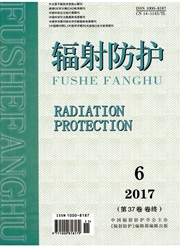

 中文摘要:
中文摘要:
通过对国内主要核电站进行调研和资料总结,根据CPR1000、AP1000和EPR三种核电机组类型排放数据,选定了我国核电站海域的重点监测核素,建立了核电站海域源项模型。以最小可探测活度浓度为主要依据,为核电站海域各重点监测核素选定了用于碘化钠探测器的首选监测的γ射线。利用蒙特卡罗模拟,计算了探测器在海水中的有效探测距离,并对比了不同的探测器封装材料对γ射线的衰减能力。研究结果可用于降低海水就地γ谱仪的最低可探测活度浓度,提高人工放射性核素的识别能力。
 英文摘要:
英文摘要:
Among several kinds of nuclear power plants in China, CPR1000, AP1000 and EPR technology are typical and selected to provide emission information of nuclides for the source model. According to the radiation background of NaI detector, preferred gamma ray peak for each nuclide was selected by comparing minimum detectable activity concentration. Effective detection range of the detector in the seawater was calculated with Monte Carlo method. Gamma-ray attenuation abilities of different packaging materials of detectors were compared. The results can be used to reduce the minimum detectable activity concentration of in-situ gamma-ray spectrometer, and to improve identification of artificial radionuclides in seawater background.
 同期刊论文项目
同期刊论文项目
 同项目期刊论文
同项目期刊论文
 A background simulation method for cosmogenic nuclides inside HPGe detectors for rare event experime
A background simulation method for cosmogenic nuclides inside HPGe detectors for rare event experime The characteristics of a low background germanium gamma ray spectrometer at China JinPing undergroun
The characteristics of a low background germanium gamma ray spectrometer at China JinPing undergroun Limits on light weakly interacting massive particles from the CDEX-1 experiment with a p-type point-
Limits on light weakly interacting massive particles from the CDEX-1 experiment with a p-type point- 期刊信息
期刊信息
